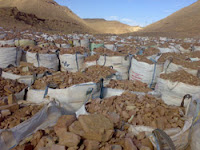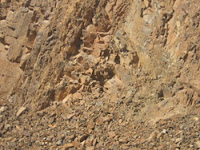To appreciate quarry and mining operations in Egypt, one must understand that without them, there would be no great Pyramids and there would be no grand temples. In fact, there would also be little in the way of glorious jewelry, exquisite statuary, or gilded furniture from ancient Egypt. To a very large extent, what we know of ancient Egypt was built from quarry and mining operations. Today, tourists would not be visiting Egypt were it not for the hard, backbreaking work of the quarrymen so many thousands of years ago.
The ancient Egyptians, as far back as prehistory, had a big appetite for various materials, and particularly limestone, which was used in huge quantities. However, they also certainly quarried red, gray and black granite from Aswan, alabaster, diorite, marble, serpentine, purple porphyry
black slate from Wadi Rahanu, basalt and dolomite. They also mined for metals, such as copper and gold, though silver was usually imported, and iron deposits were not exploited probably until the Late Period. There was also mining for precious stones, such as emeralds, malachite (sehmet, turquoise (mafaket), carnelian, amethyst and other gemstones. Mining for minerals included salt (sodium chloride), Natron, a variant of normal cooking salt, alum, a mineral used for dying cloth and Galena, a lead sulphide used in cosmetics. Finally, one of the most overlooked quarrying was simply Nile Mud, used for pottery making and for making bricks that were used in most common building applications.
Stone form the Nile Valley was quarried by those living in Egypt at least as early as 40,000 years ago, when the Middle Palaeolithic inhabitants of Middle Egypt .
were quarrying and working cobbles of chert along the limestone terraces on either side of the Nile. These earliest of Palaeolithic chert quarries consisted of pits and trenches for surface extraction, but there are Upper Palaeolithic quarries at nazlet khater 4, on the western bank of the Nile about midway between Asyut and Sohag, that include vertical shafts and subterranean galleries, which in fact foreshadow quarrying methods during the pharaonic period. When the Nazlet Khater 4 site was excavated there, a number of tools were unearthed. These included hammerstones used for the roughest stages of quarrying as well as several picks used for finer work. The picks were carved from the horns of gazelles and hartebeest.
The prehistoric Egyptians also exploited the minerals in the cliffs and deserts on either side of the Nile Valley, and in the Sinai. In fact, Archaeologists believe that the very earliest known settlers in the Sinai, arriving about 8,000 years ago, were miners, drawn by the regions copper and turquoise depoists. Some of the earliest known items of jewelry, dated to the prehistoric period, are made from Eastern Desert carnelian and sard. Copper slag is also known from the vicinity of the predynastic mines at Bir Nasib in the southern Sinai, and turquoise miners probably exploited the nearby region of Serabit el-Khadim in the Chalcolithic period.
Of course, these prehistoric operations were relatively small in comparison with the massive royal expeditions that were sent out to the Sinai and to Nubia during the first two dynasties, and downright tiny compared to later expeditions that might include almost twenty thousand men.
Some of the notable stone quarries during the Pharaonic Period include Gebel es-Silsila for sandstone, Tura and Ma'sara for fine white limestone, Qua el-Kebir for very hard limestone, Gebel el-Asr for Diorite, Hatnub and Wadi el-Garawi (near Helwan) for Egyptian alabaster (calcite), Gebel Qatrani for basalt, various types of granite from Wadi Hammamat, and several quarries around Aswan for pink granite.
In fact, there were very extensive quarry operations in and around Aswan, which became even more notable in later times. During the Roman period, the quarries there continued unabated, and columns carved from Aswan granite are found in quantity around the shores of the Mediterranean. It is, in fact, on of the "big three" decorative rocks of the Roman world, on a par with granito violetto from the Troad and Cipoillino from Greece.

Various metals were mined in Egypt, perhaps most notably gold, copper and later, iron. There were many gold mines around Egypt and in Nubia. Notable, perhaps, is Wadi Hammamat and Bir Umm Fawakhir (actually in Wadi Hammamat, which was still in use at the end of the 20th century), along with Wadi Sid, Wadi Abbed, Wadi el-Hudi, Wadi Allaqi, Buhen Semma, the al-Ela1qi Valley and about 20 kilometers west of Mons Caludianu, Abu Zawal. Copper mines include those at Timna and Serabit el-Khadim in the Sinai, and in the Eastern Desert, Wadi Araba, Wadi Sitra, the Hamash area and at Buhen and Wadi Dara. There were iron mines at Wadi Dib, Wadi Hammamat and at sites near Aswan.
Of course, the Egyptians also mined different gemstones, such as amethyst at Wadi el-Hudi and Gebel el-Asr, and turquoise at Wadi Mughara and Serabit el-Khadim. Egypt is where the worlds first emerald mine is located, in the mountain valley of Wadi Sikait in the Eastern Desert. It was mined as early as the Ptolemaic period. The Romans later referred to emeralds as Smaragdus, and named the Sikait region Mons Smaragdus, or Emerald Mountain. Another site was Wadi Gamal, near Marsa Alam, which latter earned the name Cleopatra's Emerald Mine.
Other mining and or quarry operations included, for Quartz, Gebel el-Asr, Gebel Dukhan and Gebel Fatira (the latter two of which became Mons Porphyrites and Mons Claudianus in latter times, Gebel el-Asr for gneiss, alum from the Dakhla and Kharga Oasis in the Western desert, slate from Wadi Hammamat and black slate from Wadi Rahanu. Minerals such as Natron were obviously mined as Wadi Natrun, while galena used in make up was mined at Gebel el-Zeit and Geble Rasas and porphyry was mined at Gebel Dukhan and Gebel Fatira (Mons Porphyrites and Mons Claudianus), as well as other nearby mines.
This is truly only a partial list of quarrying and mining sites in Egypt, and even of materials that were extracted. For example, the Egyptians mined a number of other semi-precious stones such as Lapis and Carnelian and Egyptian jasper.
Some of the inscriptions and graffiti associated with these mining and processing sites provide information on the dates of the expeditions, lists of various types of workmen and in rare instances, even detailed narrative accounts of specific expeditions. Considerable archaeological and textual information has survived concerning mining expeditions in pursuit of building stone, copper, gold, turquoise, malachite and a variety of other gemstones.
Obviously, during the Pharaonic Period, quarrying and mining was of prime importance to the prosperity and stability of Egypt's economy, though they attracted little attention prior to the 1980s from archaeologists. Since then, a number of archaeologists have begun to study them, with approaches ranging from the scientific provencing of stones and metals to the experimental replication of technology employed in extracting and working with the various materials.
The granite quarries at Aswan, which were first exploited at least as early as the beginning of Pharaonic times, are still in use today. Therefore a great deal of evidence concerning the ancient extraction and working of this extremely hard stone derives from extensive archaeological remains to the southeast of the modern city. It is estimated, based on surviving buildings and other monuments, that during the Old Kingdom some 45,000 cubic meters of stone were removed from these quarries. Most of that would have largely comprised the prying up of loose boulders scattered across its surface, but by the New Kingdom, the largest quantities of granite were being quarried.
The monument known as the Unfinished Obelisk is a useful piece of evidence for the quarrying and working techniques of the New Kingdom, when large numbers of obelisks were carved for the temples at Thebes and elsewhere. It dates to the 18th Dynasty, and measures nearly 42 meters in length. It derives its name from the fact that is was abandoned, no doubt reluctantly, at an advanced stage in the process of extraction, due to faults in the stone.
Work on this monument indicates that the laborers first removed the weathered upper layers of the granite, and then excavated a trench, marking out the shape of the obelisk, which was still attached to the bedrock. The .75 meter wide trench was divided into a number of .6 meter wide working areas, marked out by vertical red lines down the side of the trench, which might well have contained as many as fifty workmen around the obelisk at any one time. Here, the marks made by the quarry overseers still exist on the trench faces, indicating that the depth of each trench was periodically measured by lowering a cubit rod into it and marking the top of the rod with a triangle. Once the trench had reached the necessary depth, the workers would gradually undercut the block, a process which was just beginning in the case of the Unfinished Obelisk. Finally to move the quarried obelisk, it would have had to be pushed out horizontally, a considerably easier task than attempting to pull it vertically, upward out of the hole.
Various quarrying and mining sites dating to different periods and in differing geographical locations evidences the ancient Egyptians' skills of adaptation in different contests and circumstances. There was considerable flexibility in their procurement of stone and metals. Some ancient workers' settlements were substantial towns or villages, such as those near Aswan. At these sites, only minimal accommodation was required, since they were so near permanent towns. Sites situated in more remote locations have settlements that were much more developed, including some such as Serabit el-Khadim, that even went as far as having temples built for the workers.
One of the first quarry sites to be studied in any detail was an Old Kingdom one where relatively soft gypsum was mined at Umm el-Aswan, near the northern edge of the Fayoum region. It was surveyed and excavated in 1928 by Gertrude Caton-Thompson and Dorothea Gardner. Here, the workers had been housed in a large, sprawling settlement of at least 250 small stone-built structures. Considerable evidence was found indicating that the flint tools for quarrying, as well as some other items, were produced locally. Also, some of the gypsum appears to have been carved into small funerary items for private tombs, but large amounts were probably also






.jpg)








